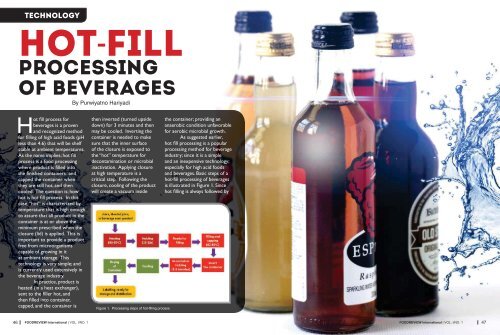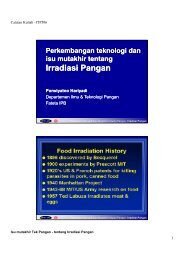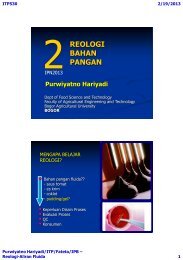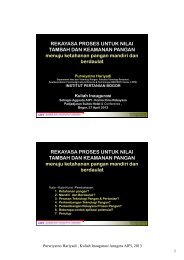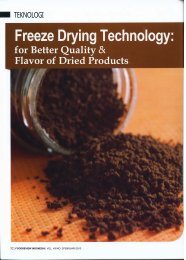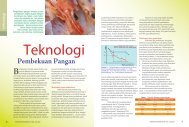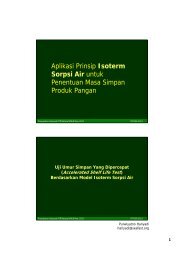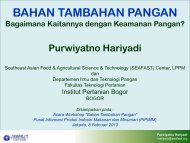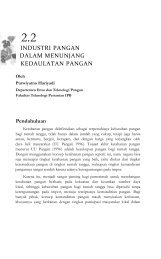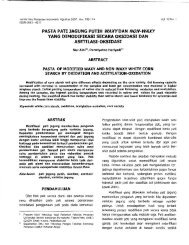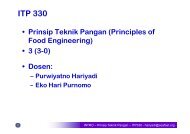HOT-FILL
HOT-FILL
HOT-FILL
Create successful ePaper yourself
Turn your PDF publications into a flip-book with our unique Google optimized e-Paper software.
technology<br />
<strong>HOT</strong>-<strong>FILL</strong><br />
PROCESSING<br />
OF BEVERAGES<br />
By Purwiyatno Hariyadi<br />
H<br />
beverages is a proven<br />
and recognized method<br />
<br />
less than 4.6) that will be shelf<br />
stable at ambient temperatures.<br />
<br />
process is a food processing<br />
<br />
<br />
capped the container when<br />
they are still hot, and then<br />
cooled. The question is; how<br />
<br />
case, “hot” is characterized by<br />
temperature that is high enough<br />
to assure that all product in the<br />
container is at or above the<br />
minimum prescribed when the<br />
closure (lid) is applied. This is<br />
important to provide a product<br />
free from microorganisms<br />
capable of growing in it<br />
at ambient storage. This<br />
technology is very simple; and<br />
is currently used extensively in<br />
the beverage industry.<br />
In practice, product is<br />
heated (in a heat exchanger),<br />
<br />
<br />
capped, and the container is<br />
then inverted (turned upside<br />
down) for 3 minutes and then<br />
may be cooled. Inverting the<br />
container is needed to make<br />
sure that the inner surface<br />
of the closure is exposed to<br />
the “hot” temperature for<br />
decontamination or microbial<br />
inactivation. Applying closure<br />
at high temperature is a<br />
critical step. Following the<br />
closure, cooling of the product<br />
will create a vacuum inside<br />
<br />
the container; providing an<br />
anaerobic condition unfavorable<br />
for aerobic microbial growth.<br />
As suggested earlier,<br />
<br />
processing method for beverage<br />
industry; since it is a simple<br />
and an inexpensive technology;<br />
especially for high acid foods<br />
and beverages. Basic steps of a<br />
<br />
is illustrated in Figure 1. Since<br />
<br />
46<br />
FOODREVIEW International | VOL. I/NO. 1 FOODREVIEW International | VOL. I/NO. 1<br />
47
(in-container) holding process<br />
then many literatures also name<br />
<br />
processing.<br />
Thermal Preservation<br />
Effects of Hot Fill<br />
Process.<br />
Hot Filling has been<br />
applied to successfully extend<br />
the shelf life of beverage<br />
products, such as fruit and<br />
vegetable juices, nectars, soft<br />
drinks, enhanced water, and<br />
RTD teas, at room temperature.<br />
<br />
<br />
determined by the thermal<br />
<br />
we can see from Figure 1, the<br />
product should be heated<br />
to 90-95 o C for about 15-30<br />
seconds; depending on pH value<br />
and other microbial factors.<br />
<br />
into the container, holding and<br />
then cooling by conduction<br />
takes place. Temperature<br />
<br />
<br />
<br />
aseptic processing can be seen<br />
in Figure 2.<br />
To assure the<br />
<br />
then it is required to have a<br />
proper control of the product<br />
<br />
including decontamination<br />
process of the container and<br />
closure. Beside microbial<br />
parameter/criteria of raw<br />
material; critical aspect need<br />
to be controlled is pH value<br />
of the product. Value of pH<br />
is an important factor in the<br />
processing of many foods,<br />
especially when a thermal<br />
processing is applied for<br />
the purpose of inactivating<br />
organisms. Consequently,<br />
monitoring of pH during<br />
production runs must be<br />
made regularly; using a proper<br />
standardized pH meter. It is<br />
important to be stressed here<br />
that the equilibrium pH of the<br />
food after processing that is of<br />
particular importance.<br />
<br />
parameters to be controlled<br />
properly are heating process,<br />
especially temperature (T hold<br />
)<br />
and time (t hold<br />
) at holding tube<br />
or holding cell, temperature<br />
<br />
),<br />
in-container holding time (t).<br />
For the same temperaturetime<br />
process parameters,<br />
pasteurization value of heat<br />
process experienced by the<br />
product is depend on the<br />
container dimensions. Filling<br />
temperature is very important<br />
in minimizing process time<br />
and ensuring adequate<br />
pasteurization process. It<br />
<br />
process parameters described<br />
above was enough to ensure<br />
adequate shelf stability. For<br />
<br />
fruits with a pH value lower<br />
than 4.0, the National Canners<br />
Association recommends<br />
<br />
temperature higher than 85°C<br />
followed by can sealing and<br />
2 min immersion in steam or<br />
water at 88°C before cooling.<br />
Guidance from Food Science<br />
Australia suggested that in most<br />
cases the product temperature<br />
<br />
less than 85°C and preferably<br />
between 90° and 95°C. The<br />
container is closed and then<br />
inverted or turned on its side<br />
for 2 or more minutes prior to<br />
cooling. Where possible foods<br />
are processed below pH 4.0<br />
with extended processing times<br />
<br />
recommended for products<br />
above that pH.<br />
<br />
effective in reducing oxidation<br />
deterioration of product. As<br />
we are aware, one of the most<br />
damaging effects resulting from<br />
oxygen activity in beverages is<br />
the oxidative degradation of<br />
vitamin C. Oxidation reaction<br />
is also closely associated with<br />
<br />
of the beverages during storage.<br />
<br />
also create natural de-aeration,<br />
generating an internal vacuum<br />
within the container after<br />
cooling. In addition to inhibiting<br />
microbial growth, vacuum<br />
condition also prevent oxidative<br />
<br />
products are generally shelf<br />
stable at ambient temperature.<br />
To assure total elimination<br />
<br />
is now also equipped with<br />
<br />
container headspace before the<br />
capping process.<br />
Packaging for Hot<br />
Filled Beverages<br />
Traditional packaging for<br />
<br />
made from steel cans, glass<br />
bottles and jars. This type of<br />
packaging material are selected<br />
for beverages because of their<br />
best oxygen barrier properties.<br />
Steel cans, glass bottles and jars<br />
is very thermo-stable; so that<br />
<br />
at higher temperature; usually<br />
between 90 to 98°C, follow by<br />
holding time for 2-3 minutes<br />
before the container is cooled<br />
in a cooling tunnel. Preheating<br />
of glass bottles is necessary<br />
<br />
the risk of glass splintering.<br />
Prior to closure the headspace<br />
of the container (can, bottle<br />
<br />
<br />
intended to create vacuum,<br />
reduces the oxygen content of<br />
the neck space and lowers the<br />
recontamination risk.<br />
Nowadays, popular<br />
packaging material for hot<br />
<br />
polyethylene terephthalate,<br />
a plastic resin and a form<br />
of polyester. Manufacturers<br />
<br />
PET plastic for its container<br />
due to its strength, thermostability,<br />
transparency, and<br />
price. Furthermore, another<br />
advantages for PET is<br />
lightweight, resealable, shatterresistant<br />
and recyclable.<br />
Thermo-stability of packaging<br />
<br />
<br />
at high temperature; capable<br />
of causing distortion or<br />
deformation of bottle used.<br />
As described earlier, the<br />
<br />
vacuum within the container<br />
(PET bottle) after cooling.<br />
This is due to, especially after<br />
cooling, the shrinkage of the<br />
liquid beverage (by 3% to 4%)<br />
coupled with condensation of<br />
water vapor in the headspace.<br />
Vacuum created by proper hot<br />
<br />
0.5 bar (7 psi). consequently;<br />
the tightness of closure is<br />
very crucial to maintain the<br />
vacuum and to avoid post<br />
contamination. Recently,<br />
special PET technology is<br />
<br />
processing, as a PET preforms<br />
made from special resins,<br />
heated to a higher temperature<br />
and blown into hot blow molds<br />
in order to reduce shrinkage<br />
and more thermo-stability.<br />
48 FOODREVIEW International | VOL. I/NO. 1 FOODREVIEW International | VOL. I/NO. 1<br />
49


